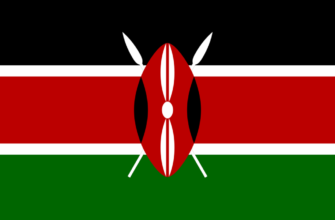The national symbols of the countries reflect the political situation and indicate the events that led to the formation of the state, the acquisition of independence – each country puts something different in the flag. The flag and the symbolic images on it are signs of the cultural or material heritage of the citizens. They can represent religious trends, the occupation of the population, as well as the presence of natural resources.
This is what the modern flag of Zimbabwe looks like:

History of the flag
In 1888, according to the treaty, the British government controlled the economic situation of the southwestern lands of Zimbabwe, and from 1895 the territory of the present republic became a colony of the British South Africa Company. At that time, the symbol was the British flag with the emblem and the company’s abbreviation in the center.

In 1896 the black inhabitants rebelled against British patronage, but were defeated. In 1922, the British Company withdrew from power and ceased to administer the lands of Southern Rhodesia, as the republic of Zimbabwe was then called.
From 1927 to 1953, the flag cloth was blue, with the British flag in the left corner and the coat of arms in the form of a green shield in the right.

For 10 years, beginning in 1953, Southern Rhodesia was part of the Federation of Rhodesia and Nyasaland and had a flag in which the green shield was replaced by the coat of arms belonging to the unity of the Southern and Northern parts of Rhodesia and Nyasaland.

However, in 1963 the Federation broke up and Zimbabwe gained independence. The old flag was returned, only the dark blue background was changed to blue.

Between 1965 and 1979, the territory of the present-day Republic of Zimbabwe was part of the unrecognized state of Southern Rhodesia and had its own special flag. The cloth was divided vertically into three stripes: the side ones were painted green and the central one was white. In the middle was the coat of arms of Zimbabwe, consisting of many elements.

The protracted civil war in 1979 ended with Britain and other countries recognizing the independence of the republic. At first it was called Zimbabwe-Rhodesia, and then it remained simply Zimbabwe. All state symbols were changed, and on April 18, 1980, the flag acquired its modern appearance.

Description
The Zimbabwe symbol is a horizontally arranged rectangle with an aspect ratio of 1:2. The cloth, divided into seven equal stripes, contains symmetrically repeating colors, with the central part acting as the axis of symmetry. On the left side of the flag is an equilateral triangle with two sides outlined in thin black lines and the top pointing to the right. In the background of the triangle is an image of a bird on a pedestal. Behind the statue is the shape of a five-pointed red star.
The colors of the Zimbabwe flag
The seven stripes on the Zimbabwean flag have a special Pan-African coloration. The central part is black and the other six, symmetrically located relative to the black stripe, are painted in red, yellow and green. Also on the cloth can be seen white, which is present on the left side of the flag in the form of a triangle.
Meaning of colors and flag symbol
The flag contains the traditional colors that symbolize the unity of the nations of the African continent. In turn, the color green is associated with the fertile land of the country and is a symbol of agriculture. Yellow is the deposits of minerals and minerals, which the land of Zimbabwe is rich in.
The red stripe imitates the color of the blood that was spilled during the struggle for the independence of the local population. Black acts as a sign of the ethnicity of the inhabitants and demonstrates the heritage of the indigenous peoples of the African country. The white triangle present on the canvas as a symbol of peaceful life, while the star reflects the citizens’ hopes for a bright future and the freedom of the nation.
The image of the Hungwe bird is the national mascot of the Republic of Zimbabwe and its cultural heritage. On the flag, the bird is colored yellow to signify the richness of natural materials.
The bird sculpture was found in 1871 under the ruins of Great Zimbabwe. The statuette was made of talcochlorite, a so-called soapstone.
The constitution of the republic contains a law stating that a person who violated the state symbol of the country is guilty of a crime and must be punished. The punishment for the inappropriate behavior is a fine not exceeding 1000 dollars or imprisonment for up to 2 years.
General information about Zimbabwe
| Official language | English, shona,
northern ndebele |
| Capital | Harare |
| Territory | 390 757 km2 |
| Population | 16,150,362 people |
| Currency | US dollar |
| Phone Code | +263 |










I recently visited Zimbabwe and saw the national flag waving proudly. It reminded me of the vibrant culture and history there. I learned how each color represents something significant, like the struggle for independence. The flag truly symbolizes the strength and resilience of its people!